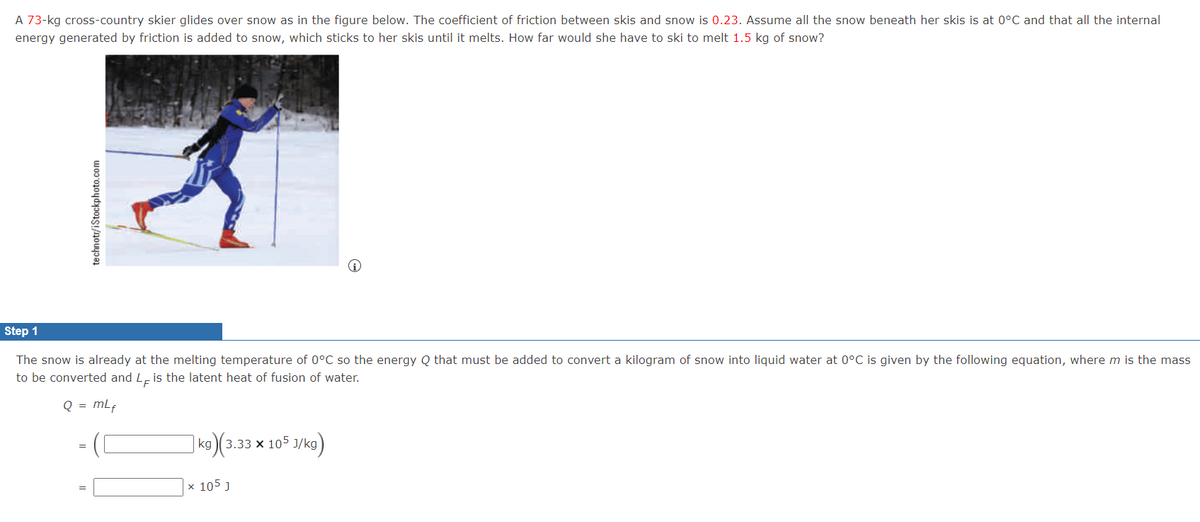A 73-kg cross-country skier glides over snow as in the figure below. The coefficient of friction between skis and snow is 0.23. Assume all the snow beneath her skis is at 0°C and that all the internal energy generated by friction is added to snow, which sticks to her skis until it melts. How far would she have to ski to melt 1.5 kg of snow? cep 1 The snow is already at the melting temperature of 0°C so the energy Q that must be added to convert a kilogram of snow into liquid water at 0°C is given by the following equation, where m is the mass to be converted and L is the latent heat of fusion of water. Q = mLf kg)(3.33 x 105 J/kg) x 105 J technotr/iStockphoto.com
A 73-kg cross-country skier glides over snow as in the figure below. The coefficient of friction between skis and snow is 0.23. Assume all the snow beneath her skis is at 0°C and that all the internal energy generated by friction is added to snow, which sticks to her skis until it melts. How far would she have to ski to melt 1.5 kg of snow? cep 1 The snow is already at the melting temperature of 0°C so the energy Q that must be added to convert a kilogram of snow into liquid water at 0°C is given by the following equation, where m is the mass to be converted and L is the latent heat of fusion of water. Q = mLf kg)(3.33 x 105 J/kg) x 105 J technotr/iStockphoto.com
Physics for Scientists and Engineers: Foundations and Connections
1st Edition
ISBN:9781133939146
Author:Katz, Debora M.
Publisher:Katz, Debora M.
Chapter19: Temperature, Thermal Expansion And Gas Laws
Section: Chapter Questions
Problem 20PQ
Related questions
Question

Transcribed Image Text:A 73-kg cross-country skier glides over snow as in the figure below. The coefficient of friction between skis and snow is 0.23. Assume all the snow beneath her skis is at 0°C and that all the internal
energy generated by friction is added to snow, which sticks to her skis until it melts. How far would she have to ski to melt 1.5 kg of snow?
Step 1
The snow is already at the melting temperature of 0°C so the energy Q that must be added to convert a kilogram of snow into liquid water at 0°C is given by the following equation, where m is the mass
to be converted and L is the latent heat of fusion of water.
Q = mL f
kg)(3.33
(3.33 × 105 J/kg)
x 105 J
technotr/iStockphoto.com
Expert Solution
This question has been solved!
Explore an expertly crafted, step-by-step solution for a thorough understanding of key concepts.
This is a popular solution!
Trending now
This is a popular solution!
Step by step
Solved in 2 steps with 2 images

Knowledge Booster
Learn more about
Need a deep-dive on the concept behind this application? Look no further. Learn more about this topic, physics and related others by exploring similar questions and additional content below.Recommended textbooks for you

Physics for Scientists and Engineers: Foundations…
Physics
ISBN:
9781133939146
Author:
Katz, Debora M.
Publisher:
Cengage Learning

College Physics
Physics
ISBN:
9781305952300
Author:
Raymond A. Serway, Chris Vuille
Publisher:
Cengage Learning

Physics for Scientists and Engineers with Modern …
Physics
ISBN:
9781337553292
Author:
Raymond A. Serway, John W. Jewett
Publisher:
Cengage Learning

Physics for Scientists and Engineers: Foundations…
Physics
ISBN:
9781133939146
Author:
Katz, Debora M.
Publisher:
Cengage Learning

College Physics
Physics
ISBN:
9781305952300
Author:
Raymond A. Serway, Chris Vuille
Publisher:
Cengage Learning

Physics for Scientists and Engineers with Modern …
Physics
ISBN:
9781337553292
Author:
Raymond A. Serway, John W. Jewett
Publisher:
Cengage Learning

Physics for Scientists and Engineers
Physics
ISBN:
9781337553278
Author:
Raymond A. Serway, John W. Jewett
Publisher:
Cengage Learning